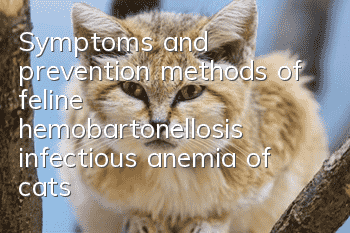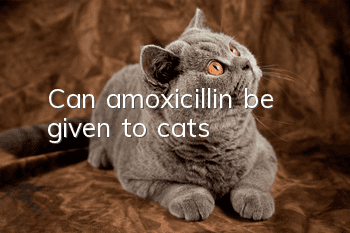Symptoms and prevention methods of feline hemobartonellosis (infectious anemia of cats)

Feline hemobartonellosis is a disease caused by parasites, also known as feline infectious anemia. The pathogenic microorganisms are generally similar in shape to Mycoplasma, but different from Bartonella haemolytica. Animals that have undergone splenectomy or have poor spleen function have obvious clinical symptoms of anemia.
Generally includes Bartonella hemolytica of large cats and Bartonella hemophilus of small cats. Bartonella hemolytica in large cats is highly pathogenic and can cause severe clinical symptoms; while Bartonella hemolytica in small cats is less pathogenic and infected cats will have subclinical symptoms. Only when they are simultaneously infected with feline immunodeficiency virus (FIV) and cats Leukemia (details) virus (FeLV), severe clinical symptoms will occur.
1. Characteristics of the disease
Domestic cats and wild cats of all ages can become infected, but domestic cats and wild cats that can go outdoors are at a higher risk of infection, and uncastrated male cats (who are prone to fighting) are also at a relatively higher risk of infection. The disease is mainly transmitted through blood. Flea and tick bites, bites from infected cats, and blood transfusions can all spread the disease. The disease can also be transmitted from mother cats to kittens, but the specific transmission route is unknown. To date, there are no reports of zoonosis of this disease. In this case, the affected cat could move freely outdoors and had been bitten by a wild cat, which may have been the cause of the disease.
2. Destructive effect on red blood cells
This pathogen mainly parasitizes on red blood cells and has a strong destructive effect on red blood cells. The main mechanism of action is:
(1) Increase the fragility of red blood cells and shorten their lifespan.
(2) Exposure to red blood cell antigens may cause changes in red blood cell surface antigens, causing the body to be unable to recognize itself and produce anti-red blood cell antibodies. Eventually, hemolytic anemia is caused, mainly manifested as extravascular hemolysis, and affected cats generally show obvious jaundice. Although no biochemical examination was performed in this case, the cat had severe jaundice.
3. Symptoms
1. Acute type. Body temperature rises to 40-41°C, depression, loss of appetite, weight loss, rapid heartbeat and breathing. Symptoms of macrocytic hemolytic anemia appear: jaundice and hemoglobinuria, visible mucous membranes are pale and jaundiced.
2. Chronic type: normal or slightly low body temperature, lack of energy, weight loss, anemia, and reduced hemoglobin.
4. Detection methods
Currently, the commonly used detection method is microscopy, and the pathogen can also be identified through serological methods and PCR methods. On microscopic examination, spherical, rod-shaped or ring-shaped basophilic substances can be seen on red blood cells in the Wright-stained blood smear. It should be noted that after using EDTA for anticoagulation, pathogens often fall off red blood cells, so it is best not to use anticoagulants in the blood used for preparation. due to thePathogens appear periodically in the blood, so general microscopy is only effective in the acute phase. Serological methods are not suitable for diagnosis of disease due to their own limitations. Currently, the most effective method for diagnosing this disease is PCR.
5. Treatment
For cats with severe anemia, supportive therapy (blood transfusion or oxygen supply) should be provided. Drugs that have been proven effective in treating this disease include doxycycline (5-10 mg/kg body weight, orally, twice a day, for 14-21 days), tetracycline (20 mg/kg body weight, orally, 1-2 times a day, Continuous use for 14-21 days), enrofloxacin (5 mg/kg body weight, orally, once a day, continuous use for 14-21 days). Penicillin and amoxicillin are ineffective. Glucocorticoids can be used appropriately to combat the body's own damage. It is important to note that treatment cannot completely kill the pathogen. The affected cat will become a lifelong carrier of the pathogen and will relapse under the influence of stress or other diseases.
6. Prevention
1. Transfusion of blood from healthy cats is the most effective method. Each transfusion can be 30 to 80 ml, once every 2 to 3 days.
2. Antibacterial drugs such as penicillin, streptomycin, tetracycline, sulfa drugs, etc. can be used.
3. Supplement ferrous sulfate, iron dextran, and vitamin B12. You can also take the blood supplement used in the medical field orally.
4. Prevention should prevent cats from fighting, scratching and biting, eliminate blood-sucking insects, and improve environmental hygiene.
- Is a female cat about to give birth when she sees red?
- How to treat cats with catnip
- Can cats eat ham after giving birth?
- Treatment methods for cat atopic dermatitis, ways to solve cat skin symptoms!
- What should pregnant cats eat to supplement calcium?
- How to train a cat? Instructions on how to train a cat!
- How to integrate cats into your life and let cats take over your life!
- How do you judge the appearance of a Bengal cat?
- What should I do if my cat is picky? Try these ways to adjust!
- What should I do if my cat has tear stains? How to clean cat tear stains?



